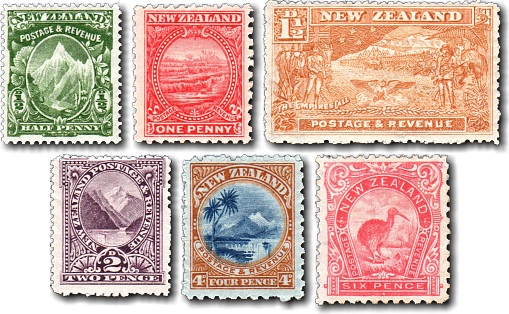
1900 Pictorials
«previous next»

| Cat. | Mint Unhinged | Mint Hinged | Fine Used | |||||
| ½d | Mount Cook / Green | 12a | $18.00 | $9.00 | $1.35 | |||
| 1d | The White Terraces | 12b | $81.00 | $36.00 | $2.25 | |||
| 1½d | Boer War Commemorative | 12c | $108.00 | $45.00 | $31.50 | |||
| 2d | Pembroke Peak | 12d | $45.00 | $22.50 | $2.70 | |||
| 4d | Lake Taupo / Mount Ruapehu | 12e | $36.00 | $16.20 | $5.40 | |||
| 6d | Red Kiwi | 12f | $157.50 | $67.50 | $16.20 | |||
| Set of 6 | 12g | $423.25 | $186.40 | $56.45 | ||||
The halfpence stamp features Mount Cook, New Zealand's highest mountain printed in green as required by the Universal Postal Union for all halfpenny stamps. Two alpine flowers are featured on the stamp - the Ranunculus and Celmisia. The stamp was also reduced in size so that 240 stamps could be printed per sheet.
The one penny stamp features the White Terraces which were produced by geothermally heated water which left thick white layers of limestone. Located on the edges of Lake Rotomahana near Rotorua, they were considered the eighth wonder of the natural world until they were completely destroyed by the violent volcanic eruption of Mount Tarawera in 1886. The eruption claimed around 150 lives and is the most violent and destructive volcanic eruption in recent history.
A new penny halfpenny stamp was introduced to cover a change in postage rates for printed matter. It commemorated the departure of the first contingents of New Zealand troops to the Boer War in South Africa and symbolised the prompt response of New Zealand to the call of the Empire for troops. A total of 6,500 New Zealand troops took part. Rather ironically, the stamp was the first to be engraved outside the British Empire, in New York.
The twopence stamp, featuring Pembroke Peak in Milford Sound, was reduced in size so that sheets of 240 stamps could be printed to reduce printing costs for this very commonly used stamp.
The four penny stamp features Lake Taupo with Mount Ruapehu in the background and a Cabbage Tree on the left. Lake Taupo is the largest lake in New Zealand covering over 600 square kilometers. The lake is well known for rainbow trout which were introduced in 1884.
The sixpence stamp featured the Kiwi as in the original 1898 issue, but printed in red because the Universal Postal Union required halfpenny stamps to be printed green.
Bibliography
The Postage Stamps of New Zealand (Volume I)
Edited by R. J. G. Collins and H. T. M. Fathers B.A. B.Sc.
Published 1938 by The Philatelic Society of New Zealand Incorporated
Pages 174 - 208, 249 - 260, 571 - 572
The Postage Stamps of New Zealand Volume II
Edited by R. J. G. Collins FRPSNZ and C. W. Watts FRPSNZ
Published 1950 by The Royal Philatelic Society of New Zealand Incorporated
Page 308
The Postage Stamps of New Zealand Volume IV
Edited by R. J. G. Collins FRPSNZ and C.W. Watts FRPSNZ
Published 1960 by The Royal Philatelic Society of New Zealand Incorporated
Pages 370 - 371
The Postage Stamps of New Zealand Volume VI
Edited by D. E. G. Naish FRPSNZ and K. J. McNaught FRPSNZ FRPSL
Publsihed 1975 by The Royal Philatelic Society of New Zealand Incorporated
Page 15
The Postage Stamps of New Zealand Volume VIII
Edited by B. G. Vincent FRPSNZ
Published 1998 by The Royal Philatelic Society of New Zealand Incorporated (ISSN 0-9597883-1-X)
Pages 705 - 708, 748 - 749
Catalogue ·
1899 ·
1900 ·
1901 ·
Definitives
Order Form · Currency Converter · Privacy Policy
What to Expect · Contact Us · Links
Order Form · Currency Converter · Privacy Policy
What to Expect · Contact Us · Links
Wishing you a Merry Christmas and a Happy and Prosperous New Year
This page was last updated on 28 Dec 2025
All content and images copyright © 2008 - 2025 StampsNZ
This page was last updated on 28 Dec 2025
All content and images copyright © 2008 - 2025 StampsNZ